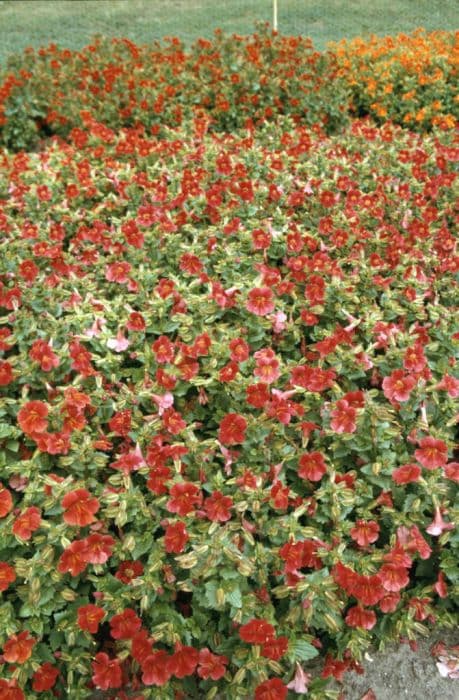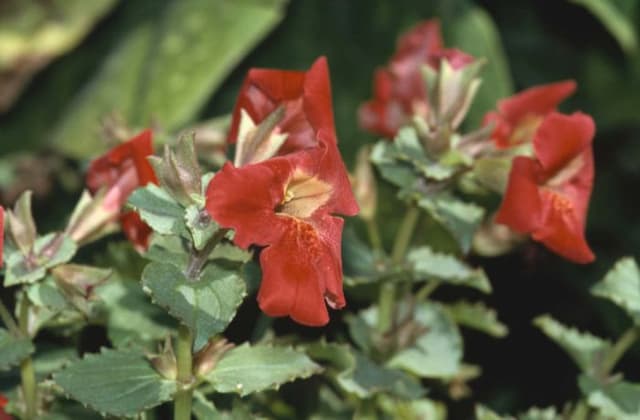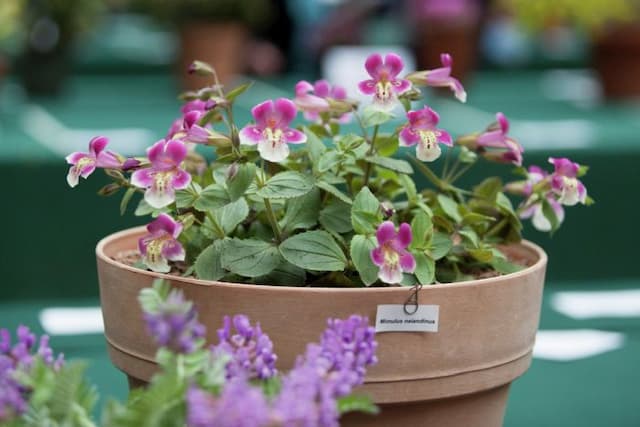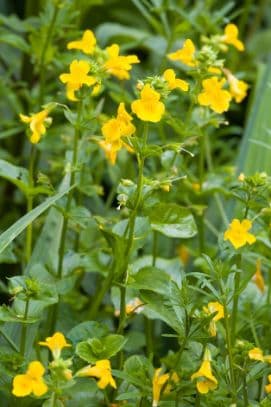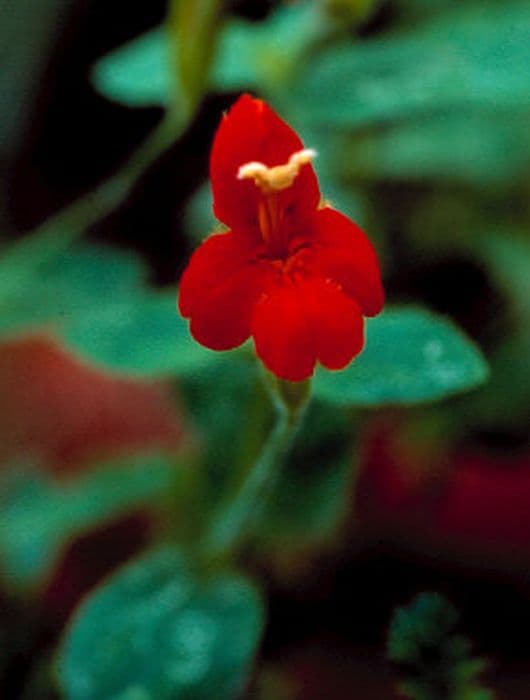Lewis's Monkeyflower Mimulus lewisii

ABOUT
Mimulus lewisii, commonly known as the Lewis's monkeyflower, is an attractive perennial plant that boasts distinct features. The plant has medium-green, oval to lance-shaped leaves that form a lush backdrop for its showy flowers. The leaves may have a slightly serrated edge, giving them a delicate texture. The most striking aspect of Lewis's monkeyflower is its flowers. These blossoms are typically large and tubular, with a two-lipped shape that is reminiscent of a monkey's face, which is how it earned its common name. The upper lip usually comprises two lobes, while the lower lip has three. The flowers typically come in shades of pink to magenta, often with some attractive darker pink or purple spotting inside the throat, which adds to their ornamental appeal. These vivid colors are particularly appealing to pollinators such as hummingbirds and bees. Lewis's monkeyflower tends to grow in clusters, forming a mass of color when in full bloom. The flowers are produced in succession over the blooming period, adding a dynamic element to its appearance since new blooms replace older ones. This makes it a plant that can deliver visual interest throughout its flowering season. Despite its delicate appearance, this plant is quite hardy and can be found thriving in its native habitats, which are typically moist areas such as stream banks or wet meadows. The overall aesthetic of Lewis's monkeyflower is one of wild beauty, as it embodies the essence of the regions where it naturally occurs.
About this plant
 Names
NamesFamily
Phrymaceae
Synonyms
Lewis's Monkeyflower, Great Purple Monkeyflower, Pink Monkeyflower
Common names
Eunanus lewisii, Mimulus lewisii var. lewisii, Mimulus lewisii var. tweedyi
 Toxicity
ToxicityTo humans
Lewis's monkeyflower is generally not known to be toxic to humans. There are no well-documented cases or significant concerns regarding its toxicity upon ingestion. Therefore, no specific symptoms of poisoning are associated with Lewis's monkeyflower in humans.
To pets
Lewis's monkeyflower is not commonly recognized as a toxic plant to pets. It does not contain known poisonous substances that could lead to symptoms of poisoning in animals. As such, there are no specific toxic effects or consequences reported for pets ingesting any part of this plant. However, it is always prudent to monitor pets for any unusual reactions when they consume plants not typically part of their diet.
 Characteristics
CharacteristicsLife cycle
Perennials
Foliage type
Deciduous
Color of leaves
Green
Flower color
Pink
Height
2 feet (0.61 meters)
Spread
2 feet (0.61 meters)
Plant type
Herb
Hardiness zones
3
Native area
North America
Benefits
 General Benefits
General Benefits- Attracts Pollinators: Mimulus lewisii, commonly known as Lewis's monkeyflower, is known for attracting bees, butterflies, and hummingbirds, which are crucial for plant pollination and maintaining healthy ecosystems.
- Aesthetic Appeal: With its beautiful pink to magenta flowers, Lewis's monkeyflower adds vibrant color and visual interest to gardens and natural landscapes.
- Erosion Control: The plant's root system can help stabilize soil in moist or wet areas, reducing erosion along streambanks or soggy terrains.
- Wildlife Habitat: Lewis's monkeyflower provides shelter and food for various small wildlife, promoting biodiversity in its native habitat.
- Low Maintenance: Adapted to wet environments, this plant generally requires minimal care once established, making it suitable for naturalistic and low-maintenance gardens.
- Educational Interest: Lewis's monkeyflower is often used in educational settings to study plant-pollinator interactions and ecology due to its distinct pollination mechanisms.
- Water Quality Improvement: By stabilizing soils and reducing runoff, Lewis's monkeyflower can help improve the quality of nearby water sources.
 Medical Properties
Medical PropertiesThis plant is not used for medical purposes.
 Air-purifying Qualities
Air-purifying QualitiesThis plant is not specifically known for air purifying qualities.
 Other Uses
Other Uses- Mimulus lewisii, commonly known as Lewis's monkeyflower, can be utilized as a natural dye source, imparting a subtle yellow to green hue to fabrics when leaves and flowers are processed appropriately.
- In garden design, Lewis's monkeyflower is used to create a visually appealing 'wild' aesthetic, especially in rock gardens or alongside creeks and ponds where its natural appearance enhances the landscape.
- Lewis's monkeyflower, due to its vibrant and attractive flowers, can serve as a tool for teaching about pollination and plant biology in educational settings.
- The plant's striking blooms are occasionally used in the art of pressed flowers, where their vibrant color and unique shape contribute to intricate designs and crafts.
- Lewis's monkeyflower is sometimes used in culinary presentations as an edible garnish, though it is not widely recognized for its flavor.
- Photographers and painters often use Lewis's monkeyflower as a subject in their work, capturing the beauty of this species in various forms of visual art.
- In certain cultures, the plant may be incorporated into traditional decorative garlands or headdresses due to its bright flowers and association with natural beauty.
- Conservationists and entomologists may use Lewis's monkeyflower to attract and study specific pollinators like bumblebees, thus aiding in conservation research efforts.
- Mimulus lewisii is utilized in water-conserving landscapes (xeriscaping) as it can thrive in moist conditions typical of such environments, helping to create sustainable garden designs.
- Because Lewis's monkeyflower can grow in challenging soil conditions, it is sometimes employed in rehabilitation efforts to stabilize soil in areas disturbed by construction or erosion.
Interesting Facts
 Feng Shui
Feng ShuiThe Lewis's Monkeyflower is not used in Feng Shui practice.
 Zodiac Sign Compitability
Zodiac Sign CompitabilityThe Lewis's Monkeyflower is not used in astrology practice.
 Plant Symbolism
Plant Symbolism- Courage: The common name for Mimulus lewisii is "Lewis' monkeyflower." Monkeyflowers are often associated with courage due to their bold colors and their ability to thrive in challenging environments.
- Fearlessness: Mimulus is derived from the Latin word for "mime" or "actor," perhaps due to the mask-like appearance of the flower's face. It symbolizes facing the world without fear, like an actor bravely takes the stage.
- Protection: The Lewis' monkeyflower is often found growing near water sources like streams or wetlands, which are essential for the survival of the ecosystem. This association lends it a symbolism of protection and sustenance.
- Overcoming Challenges: Lewis' monkeyflower has adapted to survive in moist and wet conditions that could be inhospitable to others. It symbolizes the ability to overcome environmental and personal challenges.
 Water
WaterPink Monkeyflower, or Mimulus lewisii, prefers consistently moist soil, so frequent watering is necessary. Water the plant deeply once or twice a week, providing about one gallon of water each time to ensure that the moisture reaches the root zone. During hot and dry periods, you may need to increase the frequency to three times a week, especially if you notice the soil drying out quickly. Adjust the water amount and frequency based on rainfall and changes in weather conditions to prevent waterlogged soil, which can lead to root rot.
 Light
LightPink Monkeyflower thrives best in partial shade to full sun conditions. A spot that provides morning sunlight with some afternoon shade would be ideal, especially in hotter climates. Avoid placing it in full shade, as this can lead to poor flowering and weak growth.
 Temperature
TemperatureThe Pink Monkeyflower is accustomed to a moderate climate and can survive in temperatures ranging from 34°F to 85°F. It thrives in temperatures between 60°F and 75°F, which are generally its ideal growing conditions. It is important to protect the plant from frost and extreme heat, which can be detrimental to its health.
 Pruning
PruningPink Monkeyflower benefits from pruning to encourage bushier growth and more blooms. Prune in late winter or early spring before new growth begins, cutting back the plant by about a third. Deadheading, or removing spent flowers, can be done throughout the blooming season to keep the plant tidy and promote continuous flowering.
 Cleaning
CleaningAs needed
 Soil
SoilLewis' Monkeyflower prefers moist, well-draining soil with a high organic content. The best soil mix would be a combination of peat, loamy soil, and sand to ensure adequate drainage. The pH level should be neutral to slightly acidic, around 6.0 to 7.0.
 Repotting
RepottingLewis' Monkeyflower does not typically require frequent repotting. It should be repotted every 2-3 years or when it outgrows its current pot, using a soil mix as specified above.
 Humidity & Misting
Humidity & MistingLewis' Monkeyflower thrives in moderate to high humidity conditions. The ideal range is between 40% to 70% humidity for optimal growth.
 Suitable locations
Suitable locationsIndoor
Provide bright, indirect light and keep soil consistently moist.
Outdoor
Plant in partial shade with moist, well-drained soil.
Hardiness zone
3-7 USDA
 Life cycle
Life cycleThe life of the Lewis's monkeyflower (Mimulus lewisii) begins as a seed, often requiring cold stratification to break dormancy before germination in the spring. Upon germination, the seedling grows into a juvenile plant, establishing a root system and producing its first leaves. As the plant matures, it develops a rosette of foliage and prepares for the flowering stage, usually in its second year. Flowering generally occurs during the summer months, where its pink to magenta blossoms are pollinated primarily by bumblebees. After pollination, it produces small capsules containing numerous seeds, which are eventually dispersed by wind or water. The plant persists as a perennial, dying back to the ground each winter, with the root system surviving to sprout again in the next growing season.
 Propogation
PropogationPropogation time
Spring-early summer
Mimulus lewisii, commonly known as Lewis's monkeyflower, is often propagated by seed. The ideal time for sowing seeds is in the spring, after the danger of frost has passed. To propagate Lewis's monkeyflower, collect seeds from mature plants in late summer or early fall. Sow them thinly in a container filled with a well-draining soil mix, covering them lightly with soil about an eighth of an inch (approximately 3 millimeters) thick. The container should be kept moist and be placed in a bright area without direct sunlight until germination, which typically occurs within 2-4 weeks. Once seedlings have developed true leaves and are large enough to handle, they can be carefully transplanted to their final growing location.
